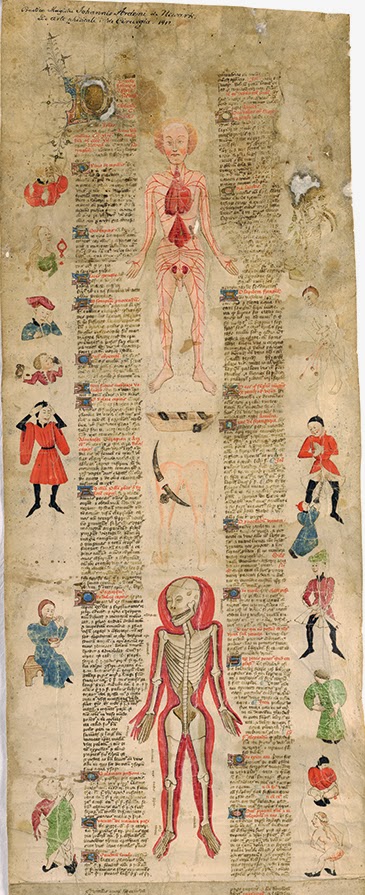The incomparable Michael Sappol--author of A Traffic of Dead Bodies, curator of Dream Anatomy, and historian at the National Library of Medicine--recently traveled to Sweden where he encountered the curious 15th century illuminated vellum scroll seen above. In the following post, Mike tells us more about this scroll, and its idiosyncratic anatomical visualizations:
I recently traveled to sunny Sweden to participate in an international conference on “The History of Medicine in Practice.” Along the way I got to visit some historical medical collections, talk to historians, curators, archivists, rare book specialists, publishers and librarians, and see amazing objects.
Today’s post is about one amazing object: De Arte Phisicali et de Cirurgica (The Art of the Physician and the Surgeon), a long vellum scroll — 542 cm (17 feet 9 inches) by 36 cm (1 foot 2 inches)! It dates from the year 1412 and resides today in the National Library of Sweden (in Swedish, Kungliga Biblioteket, “The Royal Library,” but since Swedes hold their egalitarian ideals very dear, usually translated as “The National Library”).
The manuscript is composed of six skins of vellum (that’s calf-skin!) sewn together. It features numerous painted color illustrations, along with a text written by John Arderne (1307-ca. 1390), a master surgeon who lived in Newark in the county of Nottingham, England. How it got to Sweden is a bit of a mystery, but experts believe that it traveled over the North Sea sometime in the 1420s, sent by King Henry IV of England to help his daughter, Princess Philippa. She had been married off to King Erik of Sweden in 1406 at the tender age of 12 (and died in 1430 at age 34 of a miscarriage).
The text (in Latin) contains standard medical wisdom of its time: advice on diagnosis and how to treat various conditions in the form of a discussion of cases, along with helpful recipes. (A knowledge of astrology helps with all of this.) The scroll is also supplied with a large number of good-natured, even comical, illustrations. Mostly they show the usual diseases and problems (dysentery, dropsy, colic, pleurisy, belching, insomnia, bellyache) and the usual therapeutic methods (bleeding, cautery, purging and plastering). There are also pictures of surgical instruments, poisonous animals (watch out for toads!) and typical problems of delivering a baby.
What has attracted the most attention from scholars, and even the public, are the scroll’s painted illustrations of the anatomized body, split open like a book or a butchered animal. These occupy the middle of the scroll, between the two main columns of text (which makes no comment on them), and are very rare for the period, really quite astonishing.
I know all this because of a fine book recently published on the Arderne scroll by Fri Tanke Förlag (Free Thought Press) and the Hagströmer Library, as part of their bibliographic publication series: John Arderne, De Arte Phisicali et de Cirurgia, trans., commentary, Torgny Svenberg and Peter Murray Jones; afterword, Eva LQ Sandgren (Stockholm: Fri Tanke Förlag – Hagströmer Biblioteket, 2014).
Michael Sappol
History of Medicine Division
National Library of Medicine








No comments:
Post a Comment